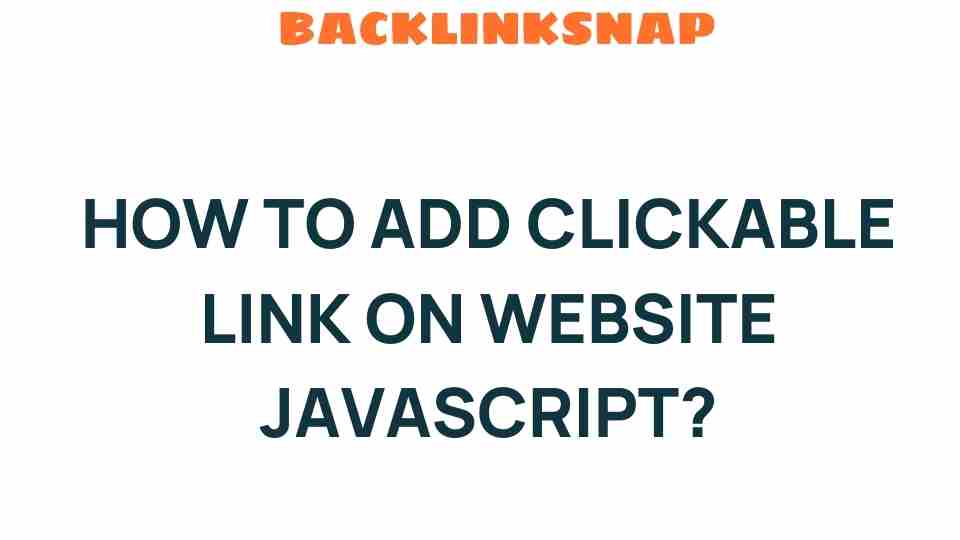Master the Art of Adding Clickable Links on Your Website with JavaScript
In the world of web development, clickable links are the lifeblood of website navigation. They serve as gateways to other pages, resources, or external sites, enhancing user experience and fostering engagement. However, the simple act of adding links can be transformed into a powerful tool by leveraging JavaScript links. This article will guide you through the essential web development techniques and coding best practices to create effective interactive elements on your site.
Understanding Clickable Links
Clickable links, or hyperlinks, allow users to navigate from one point to another, whether that’s within the same website or to an entirely different domain. They can be text-based, image-based, or even embedded in other elements like buttons. The importance of these links cannot be overstated, as they play a crucial role in guiding users, improving site navigation, and ultimately enhancing the overall user experience.
- Navigation: Links provide a straightforward path for users to follow, helping them find information quickly.
- SEO Benefits: Properly implemented links can improve your site’s search engine ranking.
- User Engagement: Engaging links can keep users on your site longer, reducing bounce rates.
Why Use JavaScript for Link Creation?
While HTML provides the foundational structure for links, integrating JavaScript links can elevate your clickable elements by adding interactivity and dynamic features. JavaScript allows developers to manipulate link behavior, manage events, and enhance user engagement. Here are a few reasons why you might want to use JavaScript for your link creation:
- Dynamic Content: Adjust links based on user actions, such as displaying different links based on user input.
- AJAX Functionality: Load content dynamically without refreshing the page, enhancing the user experience.
- Event Handling: Capture user interactions, providing feedback or triggering actions based on clicks.
Best Practices for Adding Clickable Links with JavaScript
To ensure your clickable links are effective and user-friendly, consider the following best practices:
- Descriptive Text: Use clear, descriptive text for your links. Instead of “Click here,” use “View our services” to improve accessibility and SEO.
- Open External Links in a New Tab: For external links, use the
target="_blank"attribute to keep users on your site. - Accessibility Considerations: Ensure links are keyboard-navigable and screen reader-friendly.
Implementing Clickable Links Using JavaScript
Let’s dive into a simple example of how to create a clickable link using JavaScript. This example will showcase a button that, when clicked, will navigate the user to a different webpage.
In this snippet, we create a button with the id myLink. When the button is clicked, an event listener triggers a function that changes the window’s location, effectively making it a clickable link.
Enhancing User Experience with Interactive Elements
Using JavaScript, we can enhance the user experience by adding interactive elements to our links. For example, let’s create a link that displays a tooltip when hovered over. This can provide additional context without cluttering your webpage.
Hover over me! Visit Example.com for more information!In this example, the tooltip appears when the user hovers over the link, providing them with additional information in a seamless manner. This is a fantastic way to enhance user interaction without overwhelming them with information upfront.
Link Creation and SEO
When crafting your clickable links, it’s essential to consider their impact on SEO. Here are a few tips to ensure your links contribute positively to your site’s search engine ranking:
- Use Relevant Anchor Text: Ensure your anchor text is relevant to the linked content.
- Limit the Number of Links: Too many links can dilute their effectiveness; be strategic about where you place them.
- Monitor Broken Links: Regularly check for broken links to maintain a good user experience and SEO health.
Conclusion
Mastering the art of adding clickable links using JavaScript is a valuable skill in web development. By implementing these web development techniques and coding best practices, you can create engaging, interactive elements that enhance user experience and improve website navigation. Remember, effective link creation is not just about connecting pages; it’s about guiding your users and providing them with a seamless journey through your site.
FAQs
1. What are clickable links?
Clickable links are hyperlinks that allow users to navigate to other pages or resources when clicked. They can be text-based or image-based.
2. How do JavaScript links differ from HTML links?
JavaScript links allow for more dynamic interactions, such as modifying link behavior based on user actions, whereas HTML links are static.
3. Why should I use JavaScript for link creation?
Using JavaScript for link creation enables you to add interactivity, manage events, and create dynamic content that enhances user engagement.
4. What are some best practices for creating clickable links?
Use descriptive text, open external links in a new tab, and ensure accessibility for all users.
5. How can I enhance user experience with interactive links?
You can enhance user experience by adding tooltips, animations, or AJAX functionality to your links.
6. How do clickable links affect SEO?
Properly implemented clickable links can improve your site’s SEO by providing relevant anchor text and enhancing site navigation.
For more insights on web development, feel free to explore our comprehensive guides and resources. Happy coding!
“`
This article is in the category Digital Marketing and created by BacklinkSnap Team




